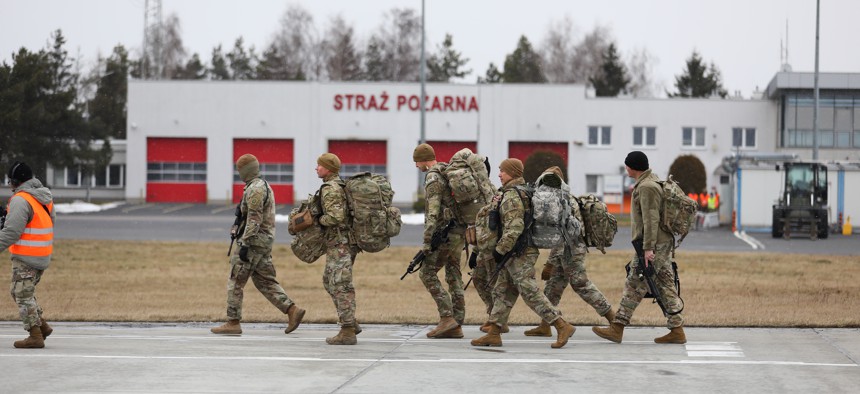
Paratroopers from the 82nd Airborne Division make their way to the terminal after arriving on a C-17 Globemaster aircraft at Rzeszów-Jasionka Airport, Poland Feb. 6. U.S. Army / Staff Sgt. Angel D. Martinez-Navedo
Biden Should Shift US Troop Positions Worldwide
The crisis in Europe makes clear that Biden’s team should rethink their first National Defense Strategy, quickly.
The deployment of military forces from bases in the U.S. to Europe should cause the Biden administration to rethink its critical defense policy priorities relevant to Russia, China, and the Indo-Pacific region.
First, the now-delayed U.S. National Defense Strategy, President Joe Biden’s first as president, likely will prioritize China as “the pacing challenge.” There is good reason to do so in light of the ongoing, sustained, broad-based Chinese military modernization effort demonstrated last year, most pointedly by China’s hypersonic missile tests.
However, Russia has one of the most advanced military forces in the world and has in many ways been much more active with its military than China has—invading Georgia in 2008, forcibly occupying and illegally annexing Crimea in 2014, deploying forces to eastern Ukraine to foment a separatist rebellion there, sending Russian forces to Syria to prop up the Assad regime, and deploying paramilitary units to Libya, among other military operations.
Thus, Russia is a much more active military adversary than China, and its priority in the NDS must be set much higher than the Defense Department had planned. In the current crisis, Russia is demonstrating both the clear intent and the ability to forcibly achieve its hostile geopolitical aims. The new NDS must ensure that the growing Russian threat is a top priority in order for the United States and its NATO allies to meet this growing challenge head on.
Second, the results of the Pentagon’s 2021 Global Posture Review released late last year were, to say the least, underwhelming in the face of the gargantuan set of new security challenges faced by the United States and its allies. Most importantly, faced for the first time since World War II with a potential conflict against two great powers simultaneously, the need to prioritize strengthening U.S. military posture in the Indo-Pacific region and in Europe lost out to an incremental, bureaucracy-driven set of outcomes. The review simply codified previously taken decisions while rightly reversing the Trump administration’s announced withdrawals from Europe.
What the Biden administration did not do in its review was to set real, stark priorities, which should be: 1. Strengthening deterrence against China, particularly regarding a potential Chinese assault on Taiwan, and 2. Buttressing the NATO deterrent against Russian coercion.
The administration also should have significantly de-prioritized U.S. military posture in the Middle East, where the relative threats are not nearly as significant as in Europe and Asia, and where capable allies and partners can contribute substantially to collective self-defense against Iran, in particular in the wake of the Abraham Accords.
The good news is that it many ways global posture will be a continually evolving process. The United States will have opportunities to get to a much more prioritized, strategy-driven set of posture enhancements, particularly to the extent that the NDS is adjusted as recommended above. And if Russia does indeed follow through on its threat to invade Ukraine, much more will need to be done across the vast expanse of the European continent to help defend NATO allies and vital U.S. interests. We will, in some ways, have entered a new security era in which Europe once again will be a continent riven by geopolitical tensions and military barricades.
Third, and very importantly, throughout the European crisis, and in particular into 2023 after the Chinese Communist Party’s 20th Party Congress enshrines Xi Jinping as president-for-life, the United States and its allies will need to keep a close eye on the Indo-Pacific region. After the November Congress, the potential for Chinese aggression against Taiwan will grow significantly. Xi will feel more secure in his position, and he will be looking for ways to make good on his commitment to reunify Taiwan with the Chinese mainland by force if necessary. With a greater proportion of U.S. forces stationed in and flowing to the European theater, the CCP leadership may see it as an opportunity to exert much greater military pressure on Taiwan.
For the duration of the Europe crisis, the U.S.-led alliance network in Europe and the Indo-Pacific will have to work much more closely together to allocate their forces to both theaters in smart ways. In particular, the United States must more clearly prioritize its Army forces for Europe. Beyond the Korean Peninsula, there should be no other top priority for the Army. Europe is where it’s needed the most, and it has very limited roles elsewhere. Conversely, U.S. naval and air forces should starkly prioritize the Indo-Pacific region for their force presence; while some U.S. air forces are needed in Europe, European and NATO air forces are relatively robust.
We do not know with certainty Putin’s next moves to disrupt the European security order. However, if the United States can get its National Defense Strategy correctly aligned to deal effectively with the new Russian threat—and use that strategy to drive smart posture enhancements in Europe and the Indo-Pacific region—then the damage to U.S. and allied interests across the world will have been minimized.
Barry Pavel is senior vice president and director of the Scowcroft Center for Strategy and Security at the Atlantic Council.





